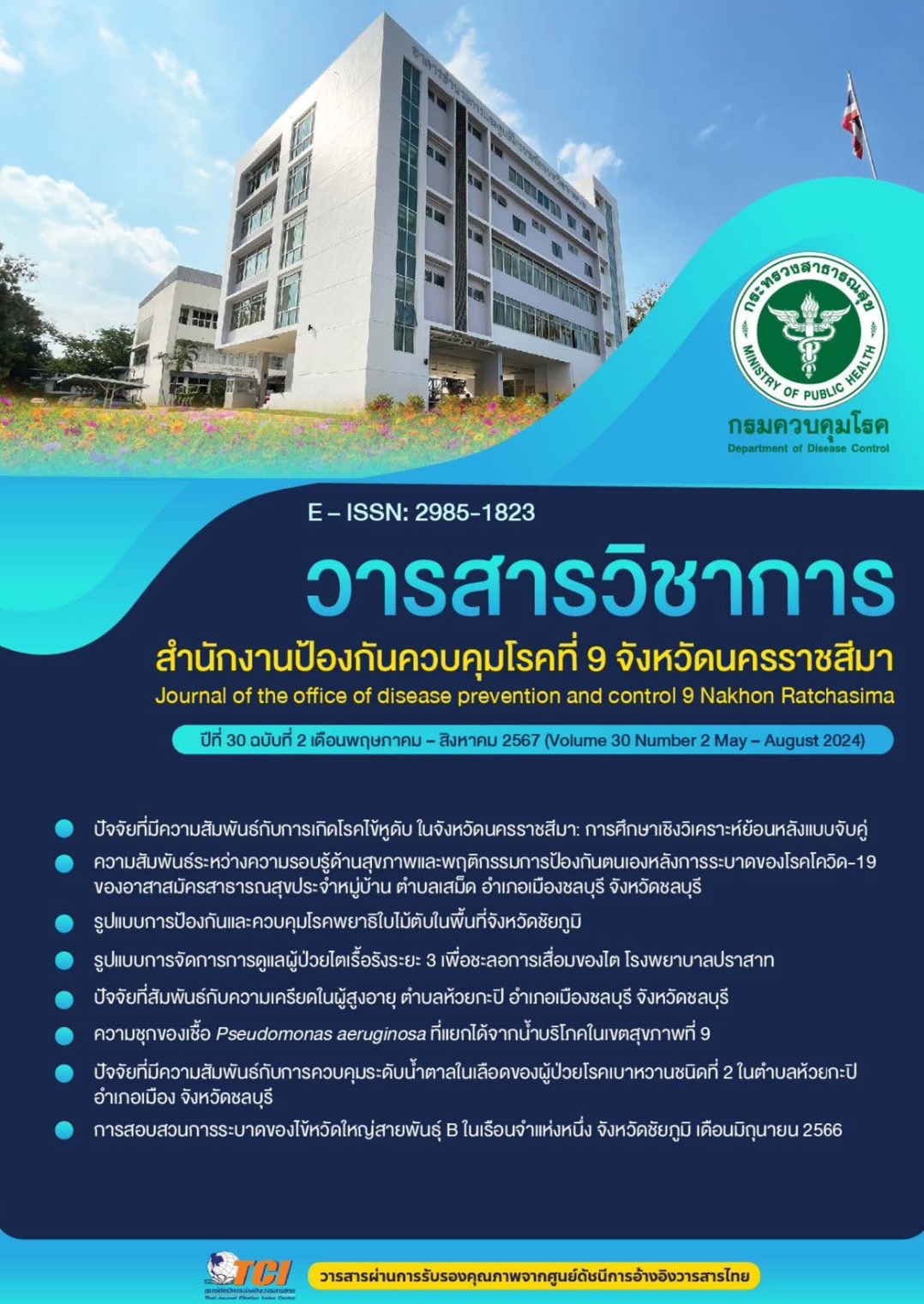A Care Management Model for Patients with Chronic Kidney Disease Stage 3 to Prevent a Slow Deterioration of the Kidneys at Prasat Hospital
Keywords:
Care management model, Patients with Stage 3 Chronic Kidney Disease, Slow deterioration of kidneysAbstract
This research focuses on two main objectives: firstly, to analyze the care provided to patients with Stage 3 Chronic Kidney Disease, and secondly, to develop a model for managing their care to decelerate kidney deterioration at Prasat Hospital. Participants were meticulously selected through purposive sampling and divided into two groups. Group 1 consisted of eight healthcare providers, including one physician, four nurses, one pharmacist, one nutritionist, and one physical therapist. Group 2 included four Stage 3 Chronic Kidney Disease patients who effectively controlled the slow deterioration of their kidneys. The researcher developed a research tool in the form of a semi-structured interview to analyze the care management for Stage 3 Chronic Kidney Disease patients, aiming to slow kidney deterioration. This tool comprised two parts: Part 1 for health service providers and Part 2 for Stage 3 Chronic Kidney Disease patients. Both parts underwent validation by five qualified experts, resulting in a content validity index of 1. The research findings highlighted two key aspects: 1) the analysis of care management for Stage 3 Chronic Kidney Disease patients identified 10 issues from health service providers and 7 issues from service recipients, and 2) the developed care management model for Stage 3 Chronic Kidney Disease had three components: (A) structure (including interdisciplinary teams, facilities, medical tools, and guidelines), (B) Process (covering health assessment, nursing care, treatment plans, self-health care promotion, discharge plans, and home visits), and (C) Results (indicating that patients can decelerate kidney deterioration). This research suggests that the care management model developed for Stage 3 Chronic Kidney Disease at Prasat Hospital can be adapted for use in other hospitals, considering the specific contexts of service providers and recipients in each area.
References
Csaba P. Kovesdy. Epidemiology of chronic kidney disease: an update 2022 [อินเตอร์เน็ต]. 2565 [เข้าถึงเมื่อ 2565 มีนาคม 15]. เข้าถึงได้จาก: https://www.ncbi.nlm.nih.gov/pmc/ articles/PMC9073222/.
กมลทิพย์ วิจิตรสุนทรกุล. ระบาดวิทยาและการทบทวนมาตรการป้องกันโรคไตเรื้อรัง. กองโรคติดต่อ กรมควบคุมโรค. 2565.
สุรัคเมธ มหาศิริมงคล และคณะ. โปรแกรม HDC กระทรวงสาธารณสุข [อินเตอร์เน็ต]. 2565 [เข้าถึงเมื่อ 2565 มีนาคม 15]. เข้าถึงได้จาก: https://hdcservice.moph.go.th/hdc/main/index.php.
มนัชญา เสรีวิวัฒนา, ยุพาวรรณ ทองตะนุนาม, สุดาวรรณ์ ลิ่มอักขรา. การพัฒนาคุณภาพการ ดูแลผู้ป่วยโรคเรื้อรังเพื่อชะลอการเสื่อมของไตโดยใช้ แนวคิดการดูแลผู้ป่วยโรคเรื้อรังของโรงพยาบาลส่ง เสริมสุขภาพตำบล. วารสารการปฏิบัติการพยาบาล และการผดุงครรภ์ไทย. 2561;5(1):45-56.
สุนีรัตน์ สิงห์คำ. การพัฒนารูปแบบการดูแลผู้ป่วยโรคไตเรื้อรังในชุมชน โดยการเสริมสร้างพลังภาคีเครือข่ายแบบมีส่วนร่วมวารสารโรงพยาบาลมหาสารคาม. 2559;13(3):92-98.
สกานต์ บุนนาค. แนวทาง implement NCD และ CKD clinic แบบบูรณาการ [อินเตอร์เน็ต]. 2558 [เข้าถึงเมื่อ 2565 มีนาคม 15]. เข้าถึงได้จาก: https://www..slideshare.net/KomolKhosi trangsikun/ckd-clinic.
สำนักวิชาการแพทย์ กรมการแพทย์ กระทรวงสาธารณสุข. รูปแบบการดูแลผู้ป่วยโรคเรื้อรัง. กรุงเทพมหานคร: สำนักงานกิจการโรงพิมพ์ องค์การสงเคราะห์ทหารผ่านศึกในพระบรมราชูปถัมภ์; 2559.
สมาคมโรคไตแห่งประเทศไทย. คู่มือการจัดการดูแลผู้ป่วยไตเรื้อรังในระยะเริ่มต้น. กรุงเทพมหานคร: บริษัทยูเนียนอุลตร้าไวโอเร็ตจำกัด; 2555.
สถาบันรับรองคุณภาพสถานพยาบาล (องค์การมหาชน). มาตรฐานโรงพยาบาลและบริการสุขภาพ. ฉบับที่ 4. นนทบุรี: บริษัท หนังสือดีวัน จำกัด; 2561.
สำนักการพยาบาล กรมการแพทย์ กระทรวงสาธารณสุข. ฉบับปรับปรุงครั้งที่ 2. นนทบุรี: โรงพิมพ์องค์การสงเคราะห์ทหารผ่านศึก; 2551.
สมาคมโรคไตแห่งประเทศไทย. คำแนะนำสำหรับการดูแลผู้ป่วยไตเรื้อรังก่อนการบำบัดทดแทนไต พ.ศ. 2558 [อินเตอร์เน็ต]. 2558 [เข้าถึงเมื่อ 2565 มีนาคม 15]. เข้าถึงได้จาก: https://www.nephrothai.org.
El Haj , HI Lamrini , M & Rais, N. Donabedian model ; Quality of care between Donabedian Model and ISO9001V2008. International Journal for Quality Research. 2013;7(1):17-30.
สำนักโรคไม่ติดต่อ กรมควบคุมโรค กระทรวงสาธารณสุข. คู่มือปฏิบัติการเพื่อดำเนินงานลดโรคไตเรื้อรัง (CKD) ในผู้ป่วยเบาหวานและความดันโลหิตสูง กลุ่มโรคไม่ติดต่อเรื้อรัง [อินเตอร์เน็ต]. 2559 [เข้าถึงเมื่อ 2565 มีนาคม 15]. เข้าถึงได้จาก: http://thaincd.com.
วรา เศลวัตนะกุล. การประเมินผลการใช้ Clinical Practice Guideline ในการรักษาคนไข้ไส้ติ่งอักเสบเฉียบพลันของโรงพยาบาลสุรินทร์. วารสารการแพทย์โรงพยาบาลศรีสะเกษ บุรีรัมย์ สุรินทร์. 2546;18(1):39-50.
ณัฐธิวรรณ พันธ์มุง, ขนิษฐา ศรีสวัสดิ์, ประภัสรา บุญทวี. ปัจจัยที่มีความสัมพันธ์กับความสำเร็จของการดำเนินงาน “คลินิกชะลอไตเสื่อม”. วารสารควบคุมโรค. 2564;47(2):353-362.
เสาวลักษณ์ ชาวโพนทอง.ผลการดูแลผู้ป่วยไตเรื้อรังโดยทีมสหวิชาชีพในคลินิกโรคไตเรื้อรังโรงพยาบาลพระนครศรีอยุธยา. วารสารสมาคมเวชศาสตร์ป้องกันแห่งประเทศไทย. 2558;5(3):197-205.
ทิพมาส ชินวงศ์. ผลของโปรแกรมสนับสนุนการจัดการตนเองเพื่อชะลอไตเสื่อมจากเบาหวานต่อพฤติกรรมการจัดการตนเองและผลลัพธ์ทางคลินิกในผู้ป่วยเบาหวานชนิดที่ 2 ที่ไม่สามารถควบคุมระดับน้ำตาลในเลือดได้. วารสารพยาบาลสงขลานครินทร์. 2560;35(1):67-84.
พิมพ์สุภัค ปานเพียรกุลภัค. ผลของโปรแกรมควบคุมอาหารสำหรับผู้ป่วยโรคไตเรื้อรังในคลินิกชะลอไตเสื่อมโรงพยาบาลพระนครศรีอยุธยา. วารสารสมาคมเวชศาสตร์ป้องกันแห่งประเทศไทย. 2559;6(3):205-15.

Downloads
Published
How to Cite
Issue
Section
License
Copyright (c) 2024 The office of disease prevention and control 9th Nakhon Ratchasima

This work is licensed under a Creative Commons Attribution-NonCommercial-NoDerivatives 4.0 International License.
บทความที่ลงพิมพ์ในวารสารวิชาการสำนักงานป้องกันควบคุมโรคที่ 9 จังหวัดนครราชสีมา ถือว่าเป็น
ลิขสิทธิ์ สำนักงานป้องกันควบคุมโรคที่ 9 จังหวัดนครราชสีมา


